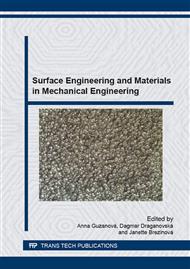[1]
A. Kalendová, Effects of particle sizes and shapes of zinc metal on the properties of anticorrosive coatings, Prog. Org. Coat. 46 (2003) 324-332.
DOI: 10.1016/s0300-9440(03)00022-5
Google Scholar
[2]
J. Havlík, A. Kalendová, D. Veselý, Electrochemical, chemical and barrier action of zinc dust/anticorrosive pigments containing coatings, J. Phys. Chem. Sol. 68 (2007) 1101-1105.
DOI: 10.1016/j.jpcs.2006.11.016
Google Scholar
[3]
A.C. Bastos, M.L. Zheludkevich, M.G.S. Ferreira, A SVET investigation on the modification of zinc dust reactivity, Prog. Org. Coat. 63 (2008) 282–290.
DOI: 10.1016/j.porgcoat.2008.01.013
Google Scholar
[4]
A. Kalendová, P. Kalenda, D. Veselý, Comparison of the efficiency of inorganic nonmetal pigments with zinc powder in anticorrosion paints, Progr. Org. Coat. 57 (2006) 1–10.
DOI: 10.1016/j.porgcoat.2006.05.015
Google Scholar
[5]
K. Schaefer, A. Miszczyk, Improvement of electrochemical action of zinc-rich paints by addition of nanoparticulate zinc, Corros. Sci. 66 (2013) 380-391.
DOI: 10.1016/j.corsci.2012.10.004
Google Scholar
[6]
S. Shreepathi, P. Bajaj, B.P. Mallik, Electrochemical impedance spectroscopy investigations of epoxy zinc rich coatings, Electr. Acta 55 (2010) 5129-5134.
DOI: 10.1016/j.electacta.2010.04.018
Google Scholar
[7]
E. Armelin, M. Martí, F. Liesab, J.I. Iribarren, C. Alemán, Partial replacement of metallic zinc dust in heavy duty protective coatings by conducting polymer, Progr. Org. Coat. 69 (2010) 26-30.
DOI: 10.1016/j.porgcoat.2010.04.023
Google Scholar
[8]
A. Kalendová, I. Sapurina, J. Stejskal, D. Veselý, Anticorrosion properties of polyaniline-coated pigments in organic coatings, Corros. Sci. 50 (2008) 3549-3560.
DOI: 10.1016/j.corsci.2008.08.044
Google Scholar
[9]
A. Kalendová, D. Veselý, I. Sapurina, J. Stejskal, Anticorrosion efficiency of organic coatings depending on the pigment volume concentration of polyaniline phosphate, Progr. Org. Coat. 63 (2008) 228-237.
DOI: 10.1016/j.porgcoat.2008.06.005
Google Scholar
[10]
S.A. Waghuley, S.M. Yenorkar, S.S. Yawale, S.P. Yawale, Application of chemically synthesized conducting polymer-polypyrrole as a carbon dioxide gas sensor, Sens. Actuators B, Chem. 128 (2008) 366–373.
DOI: 10.1016/j.snb.2007.06.023
Google Scholar
[11]
M.I. Redondo, C.B. Breslin, Polypyrrole electrodeposited on copper from an aqueous phosphate solution: Corrosion protection properties, Corros. Sci. 49 (2007) 1765–1776.
DOI: 10.1016/j.corsci.2006.10.014
Google Scholar


